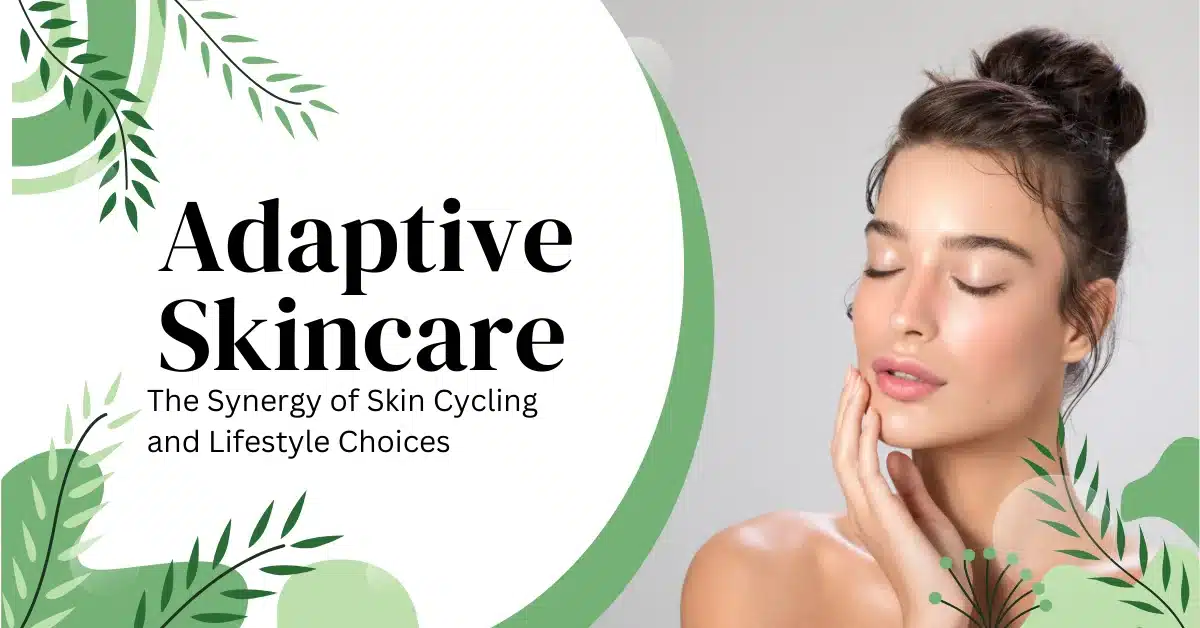Adaptive Skincare: The Synergy of Skin Cycling and Lifestyle Choices

In today’s fast-paced world, adaptability isn’t just a buzzword – it’s a necessity. Much like we pivot our plans based on life’s curveballs or adjust our wardrobe with the changing seasons, why shouldn’t our skincare get the same adaptive treatment? Dive into the world of adaptive skincare, where the principles of skin cycling merge seamlessly with conscious lifestyle choices.
Ready to synchronize your skincare routine with the rhythm of your life? Let’s uncover the beauty of staying in tune with our skin’s ever-changing needs. 🌿🧖♀️
Table of Contents
- Incorporating Skin Cycling into Your Daily Life
- Balancing Skin Cycling with Other Skincare Practices
- Conclusion: The Before and After Transformation
Incorporating Skin Cycling into Your Daily Life
Just as we adapt our wardrobe to the changing seasons, skin cycling advocates for tailoring our skincare routine based on daily needs. While the idea might seem a bit advanced for skincare newcomers, it’s a concept that can be easily integrated once you get the hang of it. Here’s a step-by-step guide to weaving skin cycling seamlessly into your daily life:
1. Understand Your Skin’s Baseline
Before diving into skin cycling, it’s crucial to identify your skin type – dry, oily, combination, sensitive, or normal. This will be your reference point. As you start skin cycling, you’ll adjust your products based on variations from this baseline.
2. Listen to Your Skin Daily
Each morning, spend a moment touching and observing your skin. Does it feel tighter? Perhaps you need more hydration. Seeing an unexpected breakout? It might be time for acne-fighting ingredients. Your skin communicates; it’s just about tuning in.
3. Organize Products for Easy Access
Have a designated space for your skincare products and organize them based on their function – moisturizing, exfoliating, anti-acne, anti-aging, etc. This way, depending on what your skin needs, you can easily grab the right product.
4. Keep a Skincare Diary
Documenting your daily observations can be enlightening. Note your skin’s condition, the products you used, and any external factors like diet, sleep, or stress. Over time, you’ll see patterns and better predict your skin’s cycles.
5. Gradual Transition is Key
For those new to skin cycling, shifting daily routines might seem overwhelming. Start by cycling one product, like a serum or moisturizer, based on your skin’s needs. As you grow more confident, you can expand this to other parts of your routine.
6. Sync with External Factors
Skin cycling isn’t just about your skin’s immediate feel. Consider external factors. If you know the next day will be sunny and you’ll be outdoors, prioritize SPF and antioxidant products. If winter sets in, it might be time to start incorporating richer, more nourishing creams.
7. Stay Updated and Educated
Skincare is an ever-evolving field. New research and products are continually emerging. Stay updated on the latest skincare trends and ingredients to make informed decisions while skin cycling.
8. Be Patient and Flexible
The essence of skin cycling is adaptability. Not every product or routine you try will be a hit, and that’s okay. If something doesn’t work, revert to what does and try something new later. Listen, learn, and adjust.
Balancing Skin Cycling with Other Skincare Practices
The skincare realm is vast and ever-evolving, with countless products, methods, and philosophies to explore. While the concept of skin cycling has emerged as a responsive approach to skincare, it’s important to understand how to harmonize it with other tried-and-true practices. After all, a holistic skincare routine is all about synergy.
1. Stick to the Essentials
Even as you rotate products based on your skin’s daily needs, there are non-negotiable steps in skincare that form the backbone of any routine:
Cleansing: The foundation of skincare, cleansing removes dirt, makeup, and impurities. It’s crucial, regardless of the day’s specific regimen.
Moisturizing: Hydration is essential. Whether you opt for a light lotion or a rich cream will depend on the skin cycling approach, but never skip this step.
SPF is Non-Negotiable: Daily SPF application remains vital, irrespective of how you adjust the rest of your routine. UV rays don’t discriminate!
2. Prioritize Patch Testing
Since skin cycling involves alternating products more frequently, it’s paramount to patch-test each new product. This will ensure your skin doesn’t react adversely, especially when introducing multiple new products in a brief period.
3. Consistency vs. Adaptability
While adaptability is the heart of skin cycling, some products, especially treatments like retinoids or certain actives, require consistent use to yield results. Find a balance. For instance, you could maintain consistency with your retinol use while cycling hydrating serums or masks.
4. Monitor and Limit Exfoliation
Exfoliation is a powerful skincare tool, but it’s easy to overdo. If you’re incorporating exfoliation into your skin cycling routine, monitor its frequency and ensure you’re not stripping your skin. Always follow up with adequate hydration.
5. The Power of Layering
One way to blend skin cycling with a comprehensive routine is to layer products. For example, if your skin feels dehydrated but you’re also addressing an acne breakout, layer a hydrating serum under your acne treatment.
6. Internal Care is Key
While topical treatments play a significant role, internal factors like diet, hydration, and stress management heavily influence skin health. Ensure you drink enough water, eat a balanced diet, and manage stress. Skin cycling can address topical concerns, but a holistic approach to health always shines through.
7. Consultation with Professionals
Dermatologists and skincare professionals offer valuable insights. When diving deep into skin cycling, a consultation can provide guidance on how to balance this method with other practices, especially if you have specific skin concerns.
8. Keep It Simple When Needed
There will be days when your skin, or simply you, need simplicity. On such days, it’s okay to strip down to basics. Listening to your skin also means respecting when it craves minimalism.
Conclusion: The Before and After Transformation
Before Skin Cycling
- You’re using the same set of products every day, irrespective of the changes in your skin’s needs or external factors like weather and stress.
- With a consistent routine, product buildup is possible, especially if you’re layering multiple products daily.
- After an initial phase of noticeable improvements, your skin doesn’t show much change even after long-term use of the same products.
- Consistently using potent actives without adjusting for your skin’s changing needs can lead to sensitization or other skin issues.
After Incorporating Skin Cycling
- Your skincare routine is adaptive, changing based on your skin’s daily or weekly needs. This could mean using hydrating products during drier days and clarifying ones when you feel a breakout coming.
- By rotating products, you minimize the risk of overwhelming your skin with too many active ingredients at once.
- As you introduce variability, your skin might become more responsive, showing improved results as it’s getting precisely what it needs.
- By using products when they’re most needed, you maximize their benefits. For instance, if you cycle in a deep hydrating serum during a particularly dry week, you’ll likely see better hydration results than using it consistently amidst varying skin conditions.
- One of the subtle “after” effects is a deeper connection with your skin. You become more attuned to its needs, understanding its signals, and responding with appropriate care.
Like all skincare practices, skin cycling might work wonders for some while proving less effective for others. The key is to listen to your skin, be patient, and find what combination of practices brings out the best in your complexion. If you’re considering giving skin cycling a try, remember that the journey – learning about your skin and its needs – is just as valuable as any transformative result.
FAQs
Q: What is skin cycling in the context of skincare?
A: Skin cycling refers to the practice of adjusting and rotating skincare products based on one’s daily or weekly skin needs. It’s about being responsive to the skin’s changing conditions, be it due to environmental factors, stress, diet, or other lifestyle elements.
Q: How does lifestyle influence the need for skin cycling?
A: Lifestyle plays a pivotal role in our skin’s health. Factors like diet, sleep patterns, stress levels, and environmental exposures can significantly impact our skin’s condition day-to-day. Skin cycling allows for adaptability, ensuring that the skin receives care tailored to its immediate needs influenced by these lifestyle factors.
Q: Are there any risks associated with skin cycling?
A: Like any skincare approach, skin cycling requires awareness. Constantly switching between potent actives without proper knowledge can lead to skin sensitization. It’s essential to understand each product’s purpose, listen to your skin’s signals, and consider patch testing when introducing new products.
Q: How can beginners start with skin cycling?
A: Beginners can start by observing their skin daily, noting its condition and any changes. Initially, focus on rotating one product type, such as serums or moisturizers, based on skin’s needs. Over time, as you become more attuned to your skin’s signals, you can expand this adaptability to other parts of your routine.
Q: How does skin cycling fit into a holistic skincare and wellness routine?
A: Skin cycling complements a holistic approach by promoting responsiveness. While certain skincare steps, like cleansing and sun protection, remain constant, other products can be rotated to address specific concerns. This adaptability, combined with a balanced diet, stress management, and healthy lifestyle choices, ensures that both internal and external factors are harmonized for optimal skin health.
References
https://www.washingtonpost.com/wellness/2022/10/12/skin-cycling-routine-care/
https://www.prevention.com/beauty/skin-care/a44821309/what-is-skin-cycling/#skin-cycling-products





